Search the Special Collections and Archives Portal
Search Results
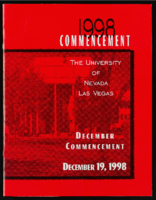
University of Nevada, Las Vegas (UNLV) 35th commencement program
Date
1998-12-19
Archival Collection
Description
Commencement program from University of Nevada, Las Vegas Commencement Programs and Graduation Lists (UA-00115).
Text
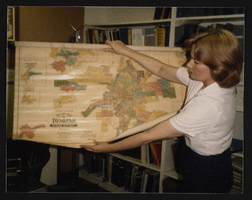
Liz Cochran of Central Nevada Museum unrolling a map, Tonopah, Nevada: photographic print
Date
1985-08
Description
From the Nan Doughty Photograph Collection (PH-00240). Liz Cochran of Central Nevada Museum receiving one of three maps donated by Nanelia Doughty.
Image
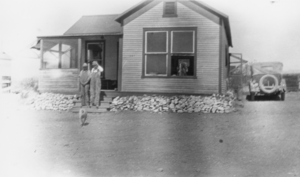
House in Carrara, Nevada: photographic print
Date
1920 to 1929
Archival Collection
Description
A house in Carrara, Nevada, probably 1920s. Nevada Photograph Collection (PH-00221) -- Series III. Beatty, Nevada -- Subseries III.F. Palsgrove Family
Image
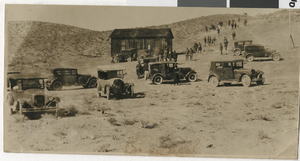
Photograph of a great rush going in the Pioche Mountains, Weepah, Nevada, 1927
Date
1927
Archival Collection
Description
A great rush is going in the Pioche Mountains where gold has been found. Prospecting to show one of the greatest gold stakes in many years.
Image
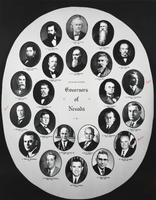
Photograph of Governors of Nevada plaque, Boulder City, Nevada, circa 1960s-1970s
Date
1960 to 1979
Archival Collection
Description
A plaque portraying the Governors of Nevada, acting and elected, in the Chamber of Commerce in Boulder City, Nevada. Description provided with image: "Pictured: 1. James W. Nye (1861-1864), 2. H.G. Blasdel (1864-1870), 3. L.R. Bradley (1871-1878), 4. John H. Kinkead (1879- 1882), 5. Jewett W. Adams (1883-1886), 6. C.C. Stevenson (1887-1890), 7. Frank Bell (1890), 8. R.K. Colcord (1891-1894), 9. John E. Jones (1895-1896), 10. Reinhold Sadler (1896-1902), 11. John Sparks (1903-1908), 12. Denver S. Dickerson (1908-1910), 13. Tasker L. Oddie (1911-1914), 14. Emmet D. Boyle (1915-1922), 15. Jas G. Scrugham (1923-1926), 16. Fred B. Balzar (1927-1934), 17. Morley Griswwold (1934), 18. Richard Kirman Sr. (1935-1938), 19. E.P. Carville (1939-1945), 20. Vail M. Pittman (1945- 1950), 21. Charles H. Russell (1951-1958), 22. Grant Sawyer (1959-1966), 23. Paul D. Laxalt (1967-)."
Image
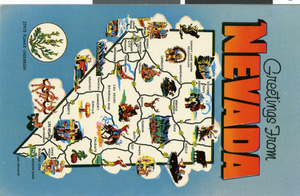
Postcard of illustrated map of Nevada, 1950s
Date
1950 to 1959
Archival Collection
Description
An illustrated postcard of the Nevada map with the state flower, a sagebrush. There are a total of twenty identified cities in the state of Nevada. "Greetings from Nevada" is written at the top.
Image
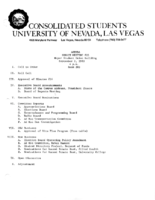
Meeting minutes for Consolidated Student Senate, University of Nevada, Las Vegas, September 02, 1980
Date
1980-09-02
Archival Collection
Description
Includes meeting agenda and minutes. CSUN Session 10 Meeting Minutes and Agendas.
Text
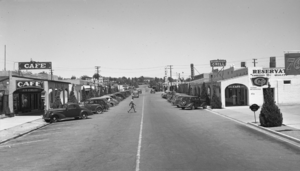
Film transparency of downtown and the Nevada Highway, Boulder City, Nevada, circa 1930-1940
Date
1930 to 1940
Archival Collection
Description
A view of downtown Boulder City and the Nevada Highway. Stores that can be seen include a cafe, a Texaco service gas station, Delmar's Drug shop, and the Reservation Grill.
Image
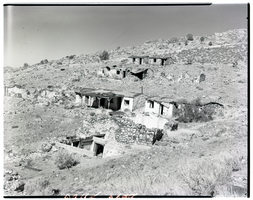
Film transparency of a ghost town, Delamar, Nevada, 1956
Date
1956
Archival Collection
Description
A view of some of the abandonded buildings on a hillside in Delamar, Nevada. One of the structures has a covered porch Delamar, Nevada, nicknamed The Widowmaker, is a ghost town in central eastern Nevada, USA along the east side of the Delamar Valley. During its heyday, primarily between 1895 and 1900, it produced $13.5 million in gold. In 1889, prospectors John Ferguson and Joseph Sharp discovered gold around Monkeywrench Wash. A mining camp was then born west of the Monkeywrench Mine. It was called Ferguson. In April 1894, Captain Joseph Raphael De Lamar bought most of the important mines in the area and renamed the Ferguson camp as Delamar. In the same year, a newspaper called the Delamar Lode began publication and a post office was opened. Soon, the new settlement boasted more than 1,500 residents, a hospital, an opera house, churches, a school, several businesses and saloons. Most buildings were made of native rock. By 1896, the Delamar mill was handling up to 260 tons of ore daily. Water for the camp was pumped from a well in Meadow Valley Wash, some twelve miles away. Supplies and materials traveled even further, by mule team over mountainous terrain from the railroad head at Milford, Utah, which was 150 miles from Delamar. Silicosis The gold in the Delamar mines was embedded in quartzite which when crushed created a fine dust. Miners breathing the dust often developed silicosis and the town became known as a "widow-maker." Many ruins now stand semi-intact in the Delamar ghost town region. Foundations can easily be seen from adjacent hills. There are two graveyards, which have been vandalized. The area is honeycombed with mines and mineshafts, but in recent years the main shaft has been blasted closed. Wild horses roam the area. The nearby dry lake is known to pilots as Texas Lake because its outline resembles the state of Texas.
Image
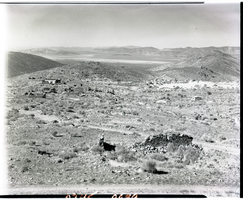
Film transparency of a ghost town, Delamar, Nevada, 1956
Date
1956
Archival Collection
Description
A view of some of the abandonded buildings in Delamar, Nevada, taken from a nearby hill. Delamar, Nevada, nicknamed The Widowmaker, is a ghost town in central eastern Nevada, USA along the east side of the Delamar Valley. During its heyday, primarily between 1895 and 1900, it produced $13.5 million in gold. In 1889, prospectors John Ferguson and Joseph Sharp discovered gold around Monkeywrench Wash. A mining camp was then born west of the Monkeywrench Mine. It was called Ferguson. In April 1894, Captain Joseph Raphael De Lamar bought most of the important mines in the area and renamed the Ferguson camp as Delamar. In the same year, a newspaper called the Delamar Lode began publication and a post office was opened. Soon, the new settlement boasted more than 1,500 residents, a hospital, an opera house, churches, a school, several businesses and saloons. Most buildings were made of native rock. By 1896, the Delamar mill was handling up to 260 tons of ore daily. Water for the camp was pumped from a well in Meadow Valley Wash, some twelve miles away. Supplies and materials traveled even further, by mule team over mountainous terrain from the railroad head at Milford, Utah, which was 150 miles from Delamar. Silicosis The gold in the Delamar mines was embedded in quartzite which when crushed created a fine dust. Miners breathing the dust often developed silicosis and the town became known as a "widow-maker." Many ruins now stand semi-intact in the Delamar ghost town region. Foundations can easily be seen from adjacent hills. There are two graveyards, which have been vandalized. The area is honeycombed with mines and mineshafts, but in recent years the main shaft has been blasted closed. Wild horses roam the area. The nearby dry lake is known to pilots as Texas Lake because its outline resembles the state of Texas.
Image
Pagination
Refine my results
Content Type
Creator or Contributor
Subject
Archival Collection
Digital Project
Resource Type
Year
Material Type
Place
Language
Records Classification
